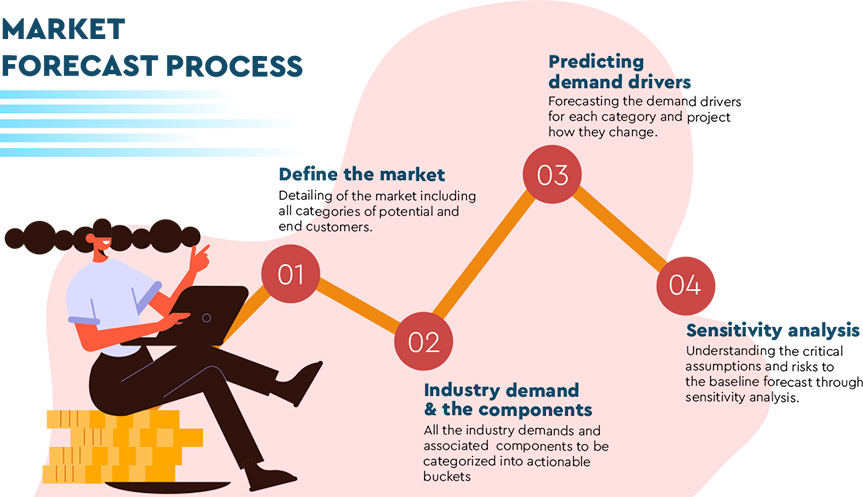Businesses across all industries have to create strategies that improve investments, resource allocation, make daily stock market forecasts, and support marketing decisions. By anticipating and understanding current trends and marketing conditions, businesses can be better prepared to succeed.
For example, Microsoft cloud services are being adopted by businesses all over the world, especially as a result of the disruption from the pandemic. Their “Intelligent Cloud” services offerings rose to $11.4 billion up from $9.61 billion. This is a classic example of an organization preparing for a market need, as businesses more than ever before need cloud services in order to improve collaboration, remote work scenarios, application development, and Software as a Service (SaaS) offerings. Market forecast services offer such information-driven foresight to drive product development and infrastructure investment.
What Is Market Forecast?
The market forecast is identifying influencing marketing factors by creating market models based on specific segmented markets that contribute to understanding and identifying key factors regarding your original market assumptions.
Basically, you can create market models by targeting specific markets and conditions, and you can create your own strategies that help you to identify where to move, change, invest, or develop.
This is important because organizations need insights into marketing patterns and trends so that they can make intelligent decisions that positively impact their business.
Every business and industry can benefit from market forecasts, including manufacturing, automotive, transportation, travel and hospitality, health and medical, pharmaceuticals, agriculture, technology, telecommunications, energy, and entertainment. Businesses need to understand the value that market forecasting can offer, like research, analysis, and data are now the driving factors for future growth and development for businesses across industries.
Market Forecasting Techniques for Precise Market Analysis
There are different types of marketing forecast techniques that help organizations make decisions and anticipate upcoming events that impact their business. With changing customer behaviors, seasonal product demands, market fluctuations, and competitive pricing maneuvers, companies have a lot to prepare for in order to best situate their business’s products and services, finances, workforce, and growth strategies. All of these evolving challenges have led to a host of new business forecasting methods, each designed to help businesses target a specific prediction-based need.

These marketing forecasts typically stem from either quantitative, time series, or causal forecasting, which are explained in more depth below:
Qualitative Methods
As qualitative research and forecasting don’t depend on the historical data, it can be used to determine the company’s strengths, weaknesses, opportunities, and threats more accurately.
- Panel Consensus: This technique is more subjective because opinions and information can be influenced by a group where several experts try to forecast conditions.
- Delphi Method: Experts are given a survey where they answer questions about a series of information, leading to fairly accurate and reliable results. All you need are questionnaires and to centralize responses.
- Market Research: This is the procedure for testing hypotheses about real market conditions that are considered very accurate for both longer predictions and new market sales, for example.
- Visionary Forecasts: Visionary forecasts were more widely used in previous years and aren’t as popular anymore because they are techniques based on personal insight and judgment from past events.
- Historical Analogy: This technique also relies on historical performance measurements, basing the results of your forecast on how products or services performed in the past.
Time Series Analysis
The main advantage of time series analysis is the accurate extrapolation of the past data and behavior into the forecasting the future roadmap.
- Box-Jenkins: This technique is great for short term forecasts and is one of the most accurate methods. It’s great for uses like inventory control using the data similar to moving average, except more historical data is used. However, it can be time and cost-intensive, so expect to devote more resources to this technique.
- X-11: This is a dependable technique for forecasts up to 2 years and is used for tracking or sales, for example. It uses seasonal trends and generally takes about 1 day to develop and make a forecast.
- Exponential Smoothing: It is fairly accurate for short term forecasts as recent data is used to compare older forecasting data.
- Moving Average: This technique is based on the average of moving data points in a series of numbers but is generally uncommon compared to other techniques and proving less accurate for short term forecasts.
- Trend Projections: This is another ideal technique for short term projections such as for testing how new products will do in the market. It requires using a few years of data to make a forecast.
Causal Methods
There are many other methods to put together data and run them all through a model to get the inferences that would be useful for pre-defined scenarios or conditions.
- Economic Input-Output Model: This is a reliable technique, but it has limited application since it can’t be used in short term forecasting because it uses long term trends in the model.
- Econometric Model: This is a highly accurate forecasting technique for short, medium, and long-term forecasts that uses an analysis of sales and profits. While it can be expensive, the accuracy levels often outweigh the cost considerations.
- Leading Indicator: This is an excellent technique for forecasting sales, but it also needs the right surveys and historical data, and it’s the best choice when it comes to long term predictions.
- Anticipated Surveys: These surveys help to determine the general public opinion about how customers react and feel about purchasing products or services. They have about an average accuracy and are better for tracking and warning.
- Life-Cycle Analysis: This technique is not used in short term predictions but can be good for new product and service sales forecasts.
- Regression: Regression models are great for forecasts of up to 2 years and compares economic, sales, and competitor variables.
- Input-Output Model: This forecasting technique is good for future predictions as long as they are not used for short term forecasts. It takes a great deal of accurate analysis and modeling to use this technique properly, and it can be very expensive, but if done properly, it’s extremely valuable for sales forecasting.
- Diffusion Index: This technique is based on percentages of economic factors and can be an accurate technique so long as the right surveys and historical data are used.
How to Pick the Most Suited Forecasting Model
When you choose the most suited forecasting models for your predictions, you have to ensure that everyone has the right information; otherwise, your models and eventual conclusions will be inaccurate – which is a waste of time, money, and resources.
- How will your forecast be used? It’s important to first consider how your forecast is going to be used. Depending on the strategy and direction that your business is taking, you will choose a particular forecasting technique. Collaboration is key as both management and analysts must be on the same page. You have to weigh the cost of making the forecast with the accuracy of that particular forecast technique, and you have to understand whether or not that forecast can be adapted and changed if the final results are inaccurate.
- Determine the elements of your forecast. What are you going to be studying in your forecast? Will it be sales, tracking, and warning, testing new products and services, or understanding market conditions? You have to identify what data you have available, as that will also help to pinpoint the technique that you can use. Once you figure all of this out, you can start to build your models.
- Do you need historical data? The longer your forecast into the future, you typically need more historical data as patterns and trends are going to change. You might not need a lot of historical data for short term predictions depending on the technique, but things change over time, like products, services, or strategies, and your data is going to change along with it. Understanding the impact and use of historical data is going to be integral to the success of the corresponding forecasting technique.
Market Forecasting Process
Creating an accurate market forecast can be a complex process if you do not understand how to proceed. Businesses need to plan for the future and can’t rely solely on past experiences and instincts to propel decision making. If you forecast total-market demand, you will be able to better understand future market conditions and consumer demand, which will ultimately help your business control its future outcomes.

- Market identification: Study your product and other competitor products in the market, including price points, volume to price, and how consumer behavior changes accordingly.
- Segment demand: It’s important to segment categories into large enough parts for analysis that account for the majority of demand.
- Predict demand drivers: Determine the demand drivers in each of the categories that you have segmented and look at how they might change in the future.
- Perform sensitivity analyses: Once you have a starting point for analysis, you have to determine how far off that analysis could potentially be, which helps to identify risks.
Market Forecast 2021 and Future-Ready Your Business
Research Optimus (ROP) is a market forecast and analysis service provider with a team of analysts tenured in performing advanced data analysis, market research surveys, and SWOT analysis for businesses. Making use of the most suited forecasting techniques for your business, ROP provides the market forecast reports for making business decisions ahead of the curve. Contact us for a detailed discussion with our analysts and how ROP can help you beat your competitors in analyzing the future market.
– Research Optimus
Disclaimer:All the product names, logos, trademarks, and brand names are the property of their respective owners. All the products, services, and organization names mentioned in this page are for identification purpose only and do not imply endorsement.
-Research Optimus




